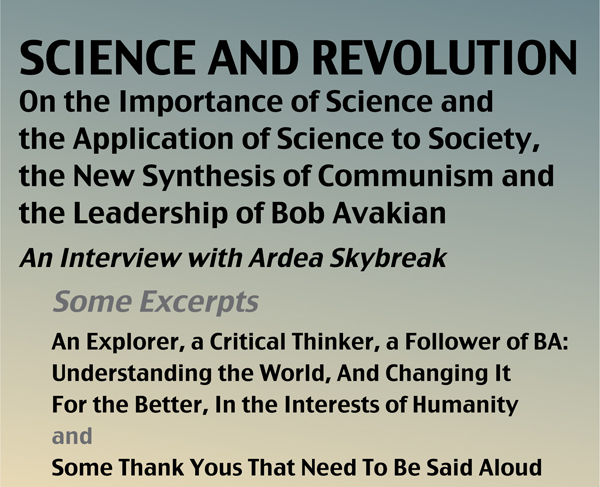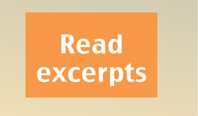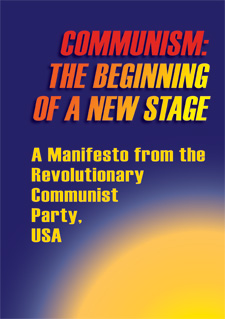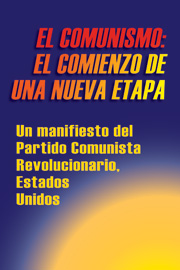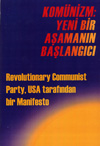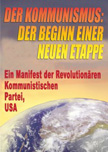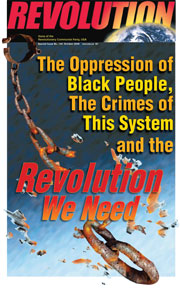The U.S. - Iran Nuclear Deal & the Imperialists’ Dilemma
by Larry Everest | September 14, 2015 | Revolution Newspaper | revcom.us
Since the article below originally appeared at revcom.us in August, an attempt by Republican senators to reject the nuclear deal negotiated between the Obama administration and five other world powers on one side and Iran on the other was defeated on September 10. That means that for now, the Iran nuclear agreement is going forward and will reportedly be formally adopted and go into effect on October 19.
The analysis in the article outlines the reactionary nature of this agreement—and the motives of the U.S. and Iran for negotiating it.
Several points made in the article have come into sharper relief in the past few weeks. First, the bitter infighting within the U.S. ruling class over the deal (and Israeli opposition to it) remains extremely sharp and, possibly in combination with developments in the region, may yet gut or derail the deal. This infighting reflects both “the imperialist dilemma” in the Middle East that is spoken to in the article as well as deeper, more all-around divisions within the U.S. ruling class.
Whether the U.S. will succeed in turning “Iran from an enemy to an ally, an ally which it hopes can help stabilize the region and eventually become part of the U.S.-dominated global order” is also far from certain. There remain sharp tensions and differences between the two countries. This was underscored by Ashton Carter, Obama’s secretary of defense, who wrote in USA Today (September 4) that the U.S. would “redouble” its anti-Iran efforts after the deal went through and that the option of a military attack on Iran would remain on the table.
This and other developments over the past month underscore that this agreement has never been about bringing “peace” or anything positive to the people. The U.S. is busily trying to repair the sharp differences that emerged with key clients Saudi Arabia and Israel over the Iran deal by offering these butcher regimes billions more in military aid. The reactionary war in Syria rages on and tensions are sharpening there between the U.S. and Russia. The U.S. imperialists continue their bloody maneuvers on many fronts to maintain dominance in the region, and thousands daily are fleeing this region that imperialism and local reactionaries have turned into an unlivable inferno.
There remains “nothing good for humanity anywhere” in this deal or the oppressive world order that produced it.
****
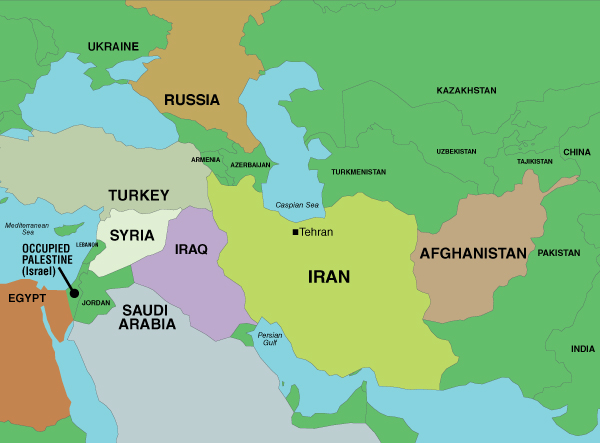
Obama claims the nuclear deal with Iran is about peace. It’s not. On both sides the deal is being driven by the needs and perceived opportunities of a global oppressive superpower (the U.S.) and a regional oppressive power (Iran). The U.S. sees enlisting Iran as a stabilizing force in a region where the U.S. empire is facing pressing threats (such as ISIS) at a time when they confront increasing challenges from rivals around the world like Russia and China. For the rulers of the Islamic Republic of Iran, this is about gaining recognition by the U.S., stabilizing their regime in the face of domestic discontent and expanding their role as a regional oppressor. There is nothing in this deal on either side, or in the arguments of belligerent opponents of the deal in the U.S. or Iran, that is in the interests of the vast majority of humanity.
On July 14, a nuclear agreement was signed between the Islamic Republic of Iran, a reactionary regional power, and the U.S. and other reactionary global powers. Iran has agreed to drastic cuts and limits to its nuclear energy and technology program and very intrusive inspections by the world’s dominant countries for at least a decade. In return, the U.S., Russia, China, Germany, France, and Britain have agreed to lift the sanctions—severe restrictions on Iran’s trade and financial dealings with other countries—that have crippled its economy and created enormous suffering for ordinary Iranians. This deal also marks the U.S.’s first official recognition of the legitimacy of the Islamic Republic and its nuclear enrichment program.
This agreement is a very big move and gamble by the rulers of all the countries involved to try to advance their own interests—not the interests of the people. It’s motivated by the enormous changes that have shaken the world and the Middle East over the past 14 years, and the deep difficulties and challenges all these powers face. The agreement has, in turn, sparked new contradictions. These include a huge fight within the U.S. ruling class, vehement opposition by key U.S. allies like Israel, and divisions among Iran’s rulers. Whether the deal moves ahead or is torpedoed isn’t certain, but either way, it’s likely to lead to other big shifts and changes. It’s important to dig through what’s going on here, because these kinds of changes and difficulties can be part of creating a situation where a real revolution becomes possible.
A Radical U.S. Shift to Deal with Big Failures and Big Problems
The wealth and power of the U.S. and the very operation of its capitalist economic and political system depend on worldwide exploitation and oppression—enforced by cold-blooded violence. For decades, controlling the Middle East has been one of the ways U.S. imperialism has dominated the planet. This region is where much of the world’s oil and natural gas are located. It’s a crossroads linking Africa, Europe, and Asia. Global trade routes run through it. And it’s very important militarily—for example, in world wars and in the global contention between rival powers. Losing control of the Middle East would be a body blow to the U.S. rulers, with profound repercussions.
Over the past 70 years, the U.S. has faced different challenges to its Middle East dominance—for example, national liberation struggles during the 1960s and the Cold War rivalry during the 1970s with the Soviet Union, which by that time had become a capitalist-imperialist power.
In recent decades, the U.S. has faced enormous new challenges concentrated in the rise of ever-more virulent strains of reactionary and often anti-U.S. Islamic fundamentalism, and sharpening conflicts with global rivals like Russia and China. In many ways these challenges have been concentrated in Iran. It is a powerful regional state with huge petroleum reserves. It’s been a major pole of Islamic fundamentalism with its own agenda and ambitions which have undercut U.S. control, and clashed with the interests of key U.S. allies Israel and Saudi Arabia. This is why the U.S. refused to recognize the Islamic Republic for over 30 years and instead tried to strangle and overthrow it. (The nuclear issue is part of this larger context: Iran has never had a nuclear weapon, but the U.S., with its huge nuclear arsenal, and Israel, which also has a large number of nukes, are determined to prevent Iran from even gaining the know-how to make a nuclear weapon.)
The George W. Bush administration tried to deal with these contradictions by invading and occupying Afghanistan in 2001 and Iraq in 2003. But those wars failed and backfired. The U.S. has not been able to crush its enemies and establish stable client regimes. Instead, the clash between reactionary, outmoded imperialism and reactionary, outmoded Islamic fundamentalism has greatly escalated in very complex and intense ways, impacting other deep problems and contradictions across this volatile region. (For example, the rapid growth of Islamic fundamentalism has stoked sectarian or religious warfare between followers of the Sunni and Shi’ite branches of Islam, which has also been directly fueled by oppressive regional powers such as Saudi Arabia and Iran.) This bubbling cauldron of contradictions now threatens to tear the region apart.
This situation has forced the Obama administration to radically change course and try to turn Iran from an enemy to an ally, an ally which it hopes can help stabilize the region and eventually become part of the U.S.-dominated global order (also attempting to make sure Iran doesn’t link up with U.S. rivals instead). The nuclear deal is seen as the first step in that process.
(Iran’s rulers also feel they need to cut this deal. These reactionary religious leaders have claimed to be revolutionaries and anti-imperialists, but their theocracy, led by Shi’ite fundamentalists, is another very oppressive form of capitalism that remains embedded in the imperialist-dominated world economic system. Their rule is threatened by the economic devastation and international isolation caused by U.S., United Nations, and European sanctions, the threats of war by the U.S. and Israel, deep discontent within Iran, and the regional growth of Sunni Jihadism.)
The Imperialist Dilemma
So why are right-wing Republicans denouncing Obama for supposedly marching Israel’s Jews to “the door of the oven” like Hitler during the Holocaust, and screaming that the U.S.’s “enemies don’t fear us, our allies don’t respect us”? And why are other ruling class critics, including some Democrats, worrying that the deal is a blunder? Because Iran still has its own needs and interests, and this deal could make it even stronger in the region (legitimizing its status and giving it access to frozen funds, investments, and global markets). This could undercut key U.S. allies like Israel and Saudi Arabia, and end up weakening U.S. regional dominance. And this deal does signal that the U.S. can’t just bomb, invade, and bully its way around the world—and that’s a very dangerous signal for a global gangster to send to rivals big and small.
Obama responds that the U.S. tried attacking and invading countries like Afghanistan and Iraq under the Republican George W. Bush, that this turned into a disaster for the imperialists, and that war with Iran could be even more dangerous for them. So now, striking a deal with Iran and getting its help is the only way to prevent the U.S. from being drained by endless wars and growing chaos in the region.
In other words, both camps among the U.S. imperialists can point to some truth—and neither has any good answers. They could be damned if they make this deal, and damned if they don’t.
Deal or No Deal—the U.S. Brings Only Horrors to the Middle East
The U.S. rulers and the region’s reactionary powers have no solutions for the contradictions they face and the unimaginable nightmares they’ve created for the peoples of the Middle East. Instead, they’re aggressively making moves to preserve their power and the very oppressive political-economic order that’s the root cause of these horrors.
Obama claims this deal means fewer nuclear weapons and less danger of nuclear war. But Iran has no nuclear weapons. It’s the U.S. and its ally Israel which together have thousands. Are either of them giving up a single nuke? No. In fact, both the U.S. and Israel have repeatedly declared their right to use military force, including nuclear weapons, anywhere they see fit. (And prominent U.S. generals argue that the deal helps the U.S. militarily.)
Obama says the agreement makes war in the region less likely. Maybe between the U.S. and Iran—for now—but meanwhile the U.S. is supporting Saudi Arabia’s merciless blockade and bombing campaign against Yemen, which has killed thousands and thrown millions into starvation. The U.S. is escalating its bombing of Syria, a country already as close to hell on earth as one can imagine. It’s collaborating with the despotic Turkish regime’s vicious assaults on Kurds in Turkey, Iraq, and Syria. The U.S. continues to support Israel—as Palestinian children are being burned alive under Israeli occupation and people in Gaza live in rubble, and as Israel continues the ethnic cleansing of the Palestinian people. And the U.S. is more responsible than any other force for all these dislocations and suffering, heartbreakingly captured by the tens of thousands of men, women, and children risking drowning to death crossing the Mediterranean Sea to escape the region’s chaos and violence.
Why should this setup be continued? Yet that’s what the U.S.-Iran nuclear agreement is about—so there’s nothing good for humanity anywhere in it. The only way to end these horrors is through communist revolution. The argument over the Iran deal shows that the rulers are not all powerful and that revolution is possible. But that won’t happen unless everyone who really wants to stop the nightmares we see or hear about every day—like constant wars—learns about and gets connected to the revolution at revcom.us. That’s where you can get into Bob Avakian—BA—the leader of the revolution, find out about the Revolutionary Communist Party’s strategy for revolution, and become part of the movement for revolution.
Volunteers Needed... for revcom.us and Revolution
If you like this article, subscribe, donate to and sustain Revolution newspaper.

